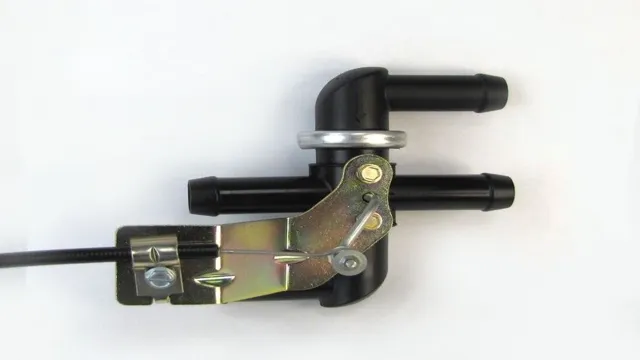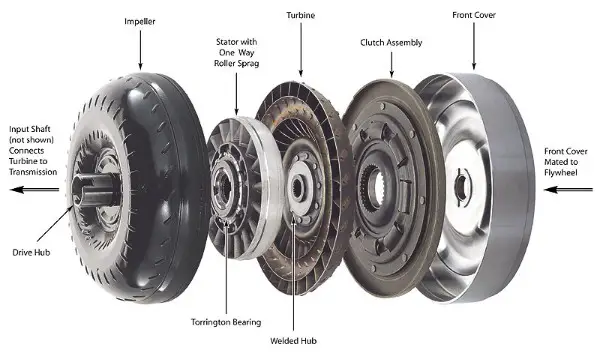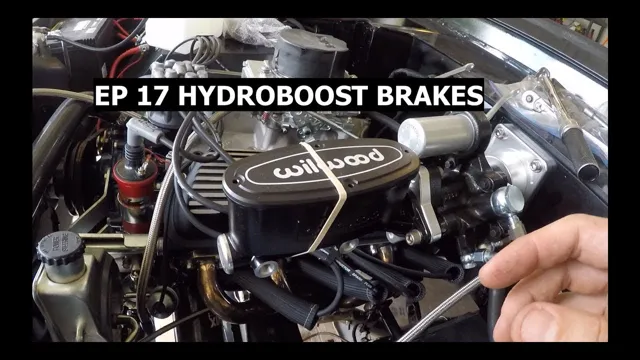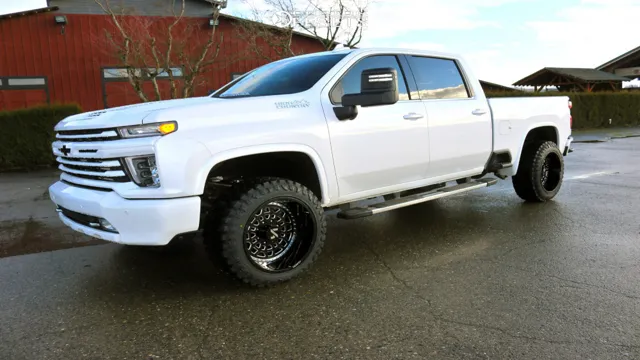Troubleshoot Your Engine Hassle-Free: Learn How to Fix a Clogged Fuel Return Line Now!
Clear fuel lines are essential for the proper functioning of your vehicle’s engine. A clogged fuel return line can lead to engine damage and, ultimately, total engine failure. This can be a frustrating issue, but fortunately, there are a few simple steps you can take to fix it.
In this blog post, we’ll walk you through the process of diagnosing a clogged fuel return line, how to fix it, and tips to prevent it from happening again. We’ll also discuss how clogs happen and why it’s important to fix them promptly. So, grab a cup of coffee and let’s dive in!
Symptoms of a Clogged Fuel Return Line
If you suspect that your vehicle is experiencing a clogged fuel return line, there are some telltale signs to look out for. One of the most common symptoms is reduced overall performance, such as hesitation or loss of power. You may also notice that your engine is laboring or stalling, particularly during acceleration or high-speed driving.
Additionally, you might experience rough idling, poor gas mileage, or a noticeable increase in emissions. To fix a clogged fuel return line, first, locate the affected line and disconnect it from the fuel rail or pressure regulator. Next, use a compressed air gun to remove any debris or blockages from the line.
Alternatively, you can also use a fuel system cleaner to help break down and remove any stubborn buildup. Finally, reattach the fuel line and test the system to ensure that everything is working correctly. Remember, regular maintenance and inspection can help prevent clogged fuel lines from occurring, so be sure to keep up with your vehicle’s recommended service schedule.
Fuel System Pressure Drops
If your vehicle is experiencing fuel system pressure drops, there could be a variety of underlying issues, including a clogged fuel return line. A clogged fuel return line can be caused by debris or dirt buildup, preventing the proper flow and return of fuel from the engine. Symptoms of a clogged fuel return line include decreased engine performance, difficulty starting the engine, and even stalling or complete engine failure.
If you notice any of these symptoms, it is important to take your vehicle to a mechanic for a proper inspection and diagnosis. Taking care of any fuel system issues promptly can prevent more significant and costly damage to your vehicle in the long run. So, keep an eye out for any alarming symptoms, and don’t hesitate to seek professional help when needed!
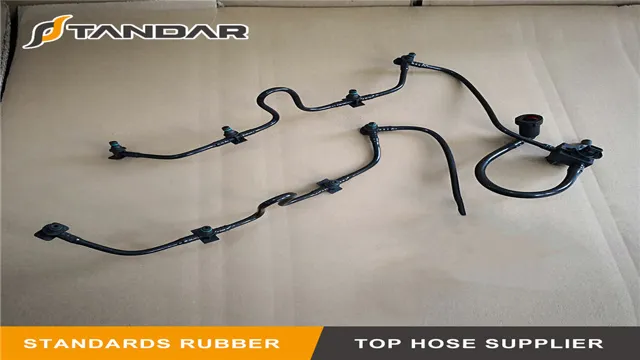
Engine Stalls or Misfires
If you’re experiencing engine stalls or misfires in your car, it could be a sign that your fuel return line is clogged. This vital component ensures that excess fuel is sent back to the fuel tank, and if it’s blocked, it can cause a range of problems. Symptoms of a clogged fuel return line include rough idling, stalling, a lack of power, and fuel odor coming from the engine bay.
Getting to the root of the problem can be tricky, as there are several potential causes of a clogged fuel return line. It could be due to a dirty fuel filter, a malfunctioning pressure regulator, or a kinked or damaged line. That’s why it’s important to have a professional mechanic diagnose and repair the issue.
Don’t wait for the problem to get worse – book an appointment with your local mechanic today and get your car back on the road in tip-top shape!
Fuel Smell in Cabin
If you’re noticing a fuel smell in the cabin of your vehicle, it could be a sign of a clogged fuel return line. This can cause fuel to backup and leak into the cabin, creating a potentially dangerous situation. Some symptoms of a clogged fuel return line include engine misfires, decreased fuel efficiency, and difficulty starting the engine.
Additionally, you might notice a rough idle or a check engine light on your dashboard. To prevent these issues, it’s important to have your fuel system checked regularly by a mechanic and to replace any worn or damaged parts as soon as possible. By doing so, you can help keep your vehicle running smoothly and safely on the road.
Tools You Will Need
Before you start fixing a clogged fuel return line, you will need a few tools to get the job done. First, you should have a set of wrenches, either metric or standard depending on your vehicle’s make and model. Additionally, having a container or drain pan to collect any fuel that may leak out during the repair is important.
A hand pump or siphon can be used to remove any excess fuel from the fuel tank, and a fuel line disconnect tool will help you remove and replace the fuel filter. It’s also a good idea to have gloves and safety glasses to protect yourself from any fuel or debris. Once you have all the necessary tools, you can begin diagnosing and fixing the clogged fuel return line to ensure your vehicle is running smoothly again.
Fuel Pressure Gauge
When it comes to checking your car’s fuel pressure, a fuel pressure gauge is a must-have tool. But before you jump into the task, here are the tools you will need to get the job done. Firstly, you’ll need a fuel pressure gauge.
Make sure to choose one that is compatible with your car’s make and model. Additionally, you’ll need a fuel pressure testing kit, which includes adapter fittings specific to your car’s fuel system. This kit will ensure that your gauge can be properly connected.
You’ll also need a wrench and a container to collect the fuel that will be released during testing. It’s essential to have a safe and efficient way to collect fuel, so be sure to use an appropriate container. Lastly, make sure to wear safety glasses and gloves to protect your eyes and skin from harmful fuel exposure.
With the right tools in hand, checking your car’s fuel pressure is a straightforward task that can help ensure your vehicle runs smoothly and efficiently.
Wrench Set
If you’re looking to tackle some DIY projects around the house, one essential tool that you’ll definitely need is a wrench set. A wrench set typically contains several different sizes and types of wrenches, which makes it easier to work on different types of nuts and bolts. One of the most important things when choosing a wrench set is to get the right size.
You don’t want to end up with a set that only has a few sizes, as this can be frustrating when you need to tighten or loosen a bolt that falls between sizes. Look for a set that has a wide range of sizes, from small to large, to ensure that you’ll always have the right tool for the job. Another important consideration is the type of wrenches included in the set.
Combination wrenches are great for both tightening and loosening nuts and bolts, while open-end wrenches are ideal for tight spaces. Ratcheting wrenches are also a great addition to any set, as they allow you to quickly and easily tighten or loosen bolts without having to reposition the wrench each time. In addition to the different types of wrenches, consider the material of the set.
Higher quality sets will be made from durable materials that can stand up to heavy use, whereas cheaper sets may bend or break after just a few uses. Look for chrome vanadium or alloy steel for a set that will last for years to come. In summary, a wrench set is an essential tool for any DIY enthusiast, and choosing the right one can make all the difference in your projects.
Look for a set with a wide range of sizes, different types of wrenches, and durable materials to ensure that you have the tools you need to get the job done right.
Safety Glasses and Gloves
When it comes to working with power tools or handling hazardous materials, safety should always come first. And the two essential tools for protecting yourself are gloves and safety glasses. These types of equipment are essential to ensure that you avoid any potential risks of injury while working.
Safety glasses are designed to shield your eyes from flying debris and other hazards, while gloves provide protection for your hands from cuts, scratches, and even chemical spills. When choosing your gloves and safety glasses, always opt for ones that fit well and are comfortable to wear. The right fit will help ensure that they won’t slip off or get in the way while you’re working.
Remember, the price of safety glasses or gloves is minimal compared to the potential cost of an injury or blindness. Don’t skimp on your safety gear – invest in quality equipment and keep yourself safe on the job.
Step-by-Step Guide
If you are having trouble with your vehicle’s fuel system and suspect a clogged fuel return line, it’s essential to take action immediately to prevent further damage. Fortunately, fixing a clogged fuel return line is a relatively simple process that you can do at home with a few basic tools. First, identify the location of the fuel return line and disconnect it from the fuel pump.
Next, use compressed air or a fuel pressure gauge to check for blockages in the line. If there is a blockage, clear it using a can of fuel injector cleaner. Once the line is unclogged, reconnect it to the fuel pump and test the system by starting the engine.
It’s important to note that a clogged fuel return line can cause issues with the fuel pressure system, resulting in engine misfires and reduced fuel efficiency. By following these steps, you can quickly and easily resolve the issue and get back on the road.
Step 1: Find the Fuel Pressure Relief Valve
The fuel pressure relief valve is a critical component of your vehicle’s fuel system. If it fails, it can lead to decreased fuel efficiency and even damage to your engine. So, it’s important to find it and check it regularly to ensure it’s working as it should.
To start, locate the valve in your vehicle’s engine compartment. It’s usually located near the fuel pump or fuel rail. Consult your owner’s manual or do a quick internet search if you’re not sure where to look.
Once you’ve found it, it’s time to check the pressure. Use a fuel pressure gauge to do this. First, relieve the pressure by removing the valve’s cap and attaching the pressure gauge to the valve.
Start the engine and monitor the pressure reading on the gauge. If it’s too high or too low, your valve may need replacing. Keep in mind that different types of vehicles may have different procedures for checking the valve, so it’s always best to consult your owner’s manual or a professional mechanic for guidance.
By regularly checking your fuel pressure relief valve, you can ensure your vehicle’s fuel system stays in top condition and avoid any costly repairs.
Step 2: Check Fuel Pressure
Checking fuel pressure is an essential step in diagnosing a car that won’t start. It can be done easily with a few tools and a bit of knowledge. First, locate the fuel pressure test port on your vehicle’s fuel rail.
Then, use a fuel pressure gauge to check the pressure against the manufacturer’s specifications. If the pressure is too low, there could be a problem with the fuel pump, fuel filter, or fuel injectors. On the other hand, if the pressure is too high, it could indicate a problem with the fuel pressure regulator.
Keep in mind that a faulty fuel pressure gauge could also give you false readings, so it’s important to use a reliable one. Checking fuel pressure is a straightforward process that can help you pinpoint the root cause of your car’s starting problem.
Step 3: Disconnect Fuel Return Line
Disconnecting the fuel return line is a crucial step in replacing your vehicle’s fuel filter. To start, you’ll need to locate the fuel tank and then find the fuel filter attached to it. Once you’ve found the fuel filter, you can now identify the fuel return line that is usually connected to the end of the filter.
Be sure to keep a container close by to catch any fuel spillage during this process. You can now use a disconnect tool to remove the fuel return line from the filter. This tool is specifically designed to fit around the line and twist it enough to release it from the connector.
Remember to wear gloves and protective eyewear during this step to avoid any accidents. Once the fuel return line is disconnected, you can proceed to remove the fuel filter from the vehicle. Following these simple steps can save you from future car problems and ensure your vehicle performs at its best.
Step 4: Inspect and Clean Fuel Return Line
After checking the fuel filter and fuel injectors in the previous steps, it’s time to move onto the fuel return line. The fuel return line is responsible for returning excess fuel back to the tank. Over time, this line can become clogged or damaged, leading to poor fuel pressure and engine performance.
Start by locating the fuel return line and visually inspecting it for any cracks or leaks. If you notice any damage, replace the line immediately. Next, detach the fuel line from the fuel pressure regulator and blow compressed air through it to clear any debris or clogs.
If you don’t have compressed air, you can use a fuel line cleaning kit, which typically includes a bottle of cleaner and a hose attachment to flush out any contaminants. Once you’ve cleaned the line, reattach it to the fuel pressure regulator and inspect for proper fit and leaks. By inspecting and cleaning the fuel return line, you’ll ensure proper fuel pressure and engine performance, leading to a smoother and more efficient driving experience.
Step 5: Reconnect Fuel Line and Check Pressure Again
Now that the fuel filter has been replaced, it’s time to reconnect the fuel lines and check the pressure again. First, make sure the fuel filter is properly secured in place. Next, reconnect the fuel lines to their corresponding ports, being sure to tighten them securely.
Once the fuel lines are reconnected, turn on the engine and check the fuel pressure gauge once again. The pressure should remain steady and within the manufacturer’s recommended range. If the pressure is too high or too low, double-check all connections and make sure the fuel filter is installed correctly.
With the fuel line reconnected and the pressure checked, you can rest assured that your engine is receiving clean fuel and running smoothly.
Preventing Future Fuel Return Line Clogs
If you’ve ever dealt with a clogged fuel return line, you know how frustrating it can be. Not only can it lead to reduced engine performance, but it can also cause damage to your vehicle’s fuel system. One way to prevent these issues is by regularly maintaining your fuel system.
This means replacing your fuel filter every 10,000 to 15,000 miles and cleaning your fuel injectors periodically. Additionally, using high-quality fuel can reduce the likelihood of clogs in your fuel line. Finally, be mindful of how you drive – aggressive driving can cause debris to build up in your fuel system.
By taking these simple steps, you can help prevent future clogs in your fuel return line, keeping your car running smoothly.
Use High-Quality Fuel Filters
Regularly replacing your fuel filter with high-quality options is a crucial step in ensuring that your engine continues to run smoothly without any issues. Not only do fuel filters help to clean the fuel, but they also prevent dirt and debris from entering the engine’s sensitive parts. A clogged fuel return line is a common issue that many vehicle owners face, which can cause a range of problems, such as decreased fuel efficiency, engine misfires, and hard starting.
However, by using high-quality fuel filters, you can prevent future fuel return line clogs and keep your engine working optimally. These filters are designed to trap even the smallest particles, ensuring that your fuel is free from contaminants. By investing in good quality filters, you can rest easy knowing that your engine is protected against any potential damage that could occur due to clogs or other mechanical issues.
Keyword: Fuel Filters
Regular System Maintenance and Inspection
Regular system maintenance and inspection is essential for preventing future fuel return line clogs. Fuel return lines play an important role in the proper functioning of an engine’s fuel system. When fuel return lines become clogged, it can cause trouble with the engine’s performance and efficiency.
To prevent future clogs, it’s essential to conduct regular system maintenance and inspections. This process involves checking the fuel filter, fuel injectors, and fuel lines for signs of damage or wear and tear. Furthermore, it’s recommended to use a high-quality fuel additive that can keep the fuel lines and injectors clean, as well as prevent harmful deposits from forming.
With regular maintenance and inspections, you can keep your engine running smoothly and avoid costly and frustrating repairs down the road. So, make sure to schedule regular maintenance and inspections and invest in high-quality fuel additives to prevent fuel return line clogs and extend the life of your engine.
Avoid Low-Quality Fuel
When it comes to preventing future fuel return line clogs, one of the most important steps is to avoid using low-quality fuel. Poor quality fuel can contain impurities and debris that can quickly build up in your vehicle’s fuel system, leading to blockages and other issues down the line. To ensure you’re using the highest quality fuel possible, be sure to only fill up at reputable gas stations and avoid purchasing from discount or off-brand sources.
Additionally, consider using high-quality fuel additives and cleaners as part of your regular vehicle maintenance routine, as these can help keep your fuel system running smoothly and prevent clogs from occurring. By taking these steps and being mindful of the fuel you’re using, you can help prevent future issues and ensure your vehicle runs as smoothly as possible.
Conclusion
In conclusion, fixing a clogged fuel return line requires a delicate balance of technical know-how and common sense. You must be brave enough to get down in the muck and grime to assess the problem, yet wise enough to seek professional help if necessary. Remember, prevention is always the best solution, so keep your fuel system clean and well-maintained.
And if all else fails, don’t forget the power of a good old-fashioned plunger. With these tips in mind, you’ll be running smoothly in no time. Happy motoring!”
FAQs
What causes a fuel return line to become clogged?
The most common causes of a clogged fuel return line are sediment or debris that accumulate over time, a damaged fuel filter, or a faulty fuel pressure regulator.
How can I tell if my fuel return line is clogged?
Signs of a clogged fuel return line include difficulty starting the engine, loss of power or acceleration, stalling, and a strong smell of gasoline.
Can I unclog my fuel return line myself?
It is best to have a professional mechanic inspect and fix a clogged fuel return line. Attempting to fix it yourself may cause further damage or lead to safety hazards.
How much does it cost to repair a clogged fuel return line?
The cost of repair will depend on the extent of the damage and the type of vehicle. On average, it can cost between $150 to $500 for parts and labor. It is recommended to get a quote from a trusted mechanic before proceeding with the repair.


